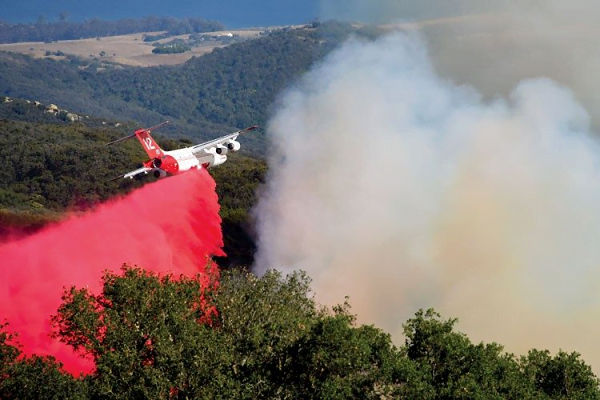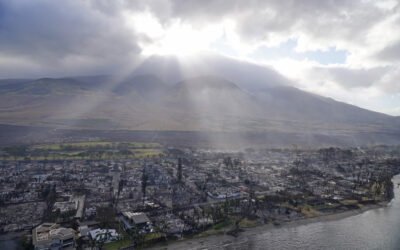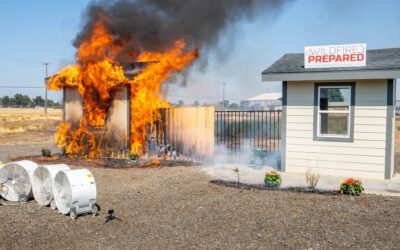A danger in the face of climate change

Climate change has produced extreme weather that supports extended wildfire seasons and destructive wildfires. (Photo by Keith D. Cullom/www.fire-image.com.)
Dena Ali | FireRescue Magazine Volume 12, Issue 7
The projected impacts of climate change-induced global warming are frightening. The thought of milder winters may sound promising to some, but the implications of warmer artic weather are devastating. As glaciers melt, sea levels rise, rain patterns change, and extreme weather patterns bring devastation to communities. The 2016-2017 North Carolina winter was mild, and now residents are experiencing the negative effects: more mosquitos, termites, and pollen.
Researchers have predicted a continued increase in severe weather patterns, disease, coastal degradation, droughts, and increased severe wildfire seasons because of increased temperatures and dryness caused by climate change. Drought conditions result from hot and dry climate and increase forest flammability by making the contents more susceptible to ignition through reduced fuel moisture. While periodic wildfires are a natural part of a fire-adapted ecosystem, uncontrolled wildfires occurring in the wildland urban interface (WUI) are catastrophic.1 WUI fires affect not only the wildland burned but also the lives of those who live in this region and its economy. Burned land areas in the United States have increased by one third from 2002 to 2011, and this increase is predicted to continue. (1) Two of the main consequences of climate change on wildfires are extended fire season because of earlier snowmelt and continued drought conditions.2
Climate change, specifically global warming, has contributed to increased incidence of wildfires and the lengthening of wildfire seasons. However, there are other factors that contribute to the loss of life and property and environmental damage resulting from wildfires. The fire service must focus on wildland fire scene preparation, training, and management. Increasing focus toward wildland fire education and training will assist with limiting the damage caused by wildfires. Many urban fire departments have limited training on wildfires because of the historical separation between urban firefighting and wildland firefighting. In fact, most urban firefighters have no training or experience when it comes to a wildland fire. While the WUI comprises 10 percent of the United States, career wildland firefighters make up only five percent of the total number of career firefighters in the United States.
The aim of this article is to focus on policy recommendations to help prevent the escape of future wildfires and assist suppression forces tasked with protecting life and property by combating wildfires. Preventing the escape of wildfires is economically beneficial to governments tasked with suppression and will mitigate the direct emissions resulting from severe wildfires. Wildfires release particulate matter and other air pollutants that contribute to the degradation of air quality. (1) It is hypothesized that policies aimed at controlling climate change and limiting the opportunity for a wildfire to escape initial attack will mitigate negative societal impacts of wildfires. Additionally, encouraging structural fire departments to focus on training and preparation to assist wildland firefighting operations is expected to prevent future escaped wildfires.
Increasing Temperatures
The planet has entered a state of rapid environmental change that can most commonly be seen today in our forests.3 Temperature, humidity, precipitation, wind, and lightning have been found to have the greatest influence on escaped forest fires.4 (1) However, of these, temperature is the strongest predictor of increased fire potential. (1, 4) Understanding the difference between weather and climate is important when considering the impact of temperature on forest fires. Climate represents a mean temperature and weather represents variation in temperature.5 Earth’s average surface temperature has increased approximately 0.8°C over the past 130 years, and if human-generated emissions of greenhouse gases continue to rise, earth may warm by more than 4°C by the end of the century. (5) Over the past 1,000 years, researchers and scientist have attributed 64 percent of temperature variations to two main natural causes, solar irradiance and volcanism.6
However, the warming in the past century has been substantially higher than previous years, and only 25 percent of the 20th century temperature increase can be attributed to natural variability. (6) This finding suggests that the sharp increase in temperature is a result of greenhouse gas increases. (6) Burning carbon produces CO2 and other greenhouse gases (GHGs) that accumulate in the atmosphere, which results in higher global temperatures, greater climate variability, and increases in sea level.7 Longer growing seasons lead to reduced CO2 uptake in high-elevation forests during droughts and contribute to wildfire activity. Increased wildfire activity amplifies the threats to human communities (death and destruction) and ecosystems and increases the challenges in restoring forests and reducing greenhouse gas emissions.8
Scientists predict that a further increase of just 2°C would significantly endanger communities on earth. (8) As mentioned, increased temperature has been found to increase wildfire occurrence and the length of wildfire seasons.9,10 (4) “Fire seasons are getting longer and more intense because of drought, climate change, deterioration of forest health, and other factors.” (10) Westerling et al. (2006) found the incidence of large wildfires increased in the mid-1980s along with wildfire seasons. They reported that the average season length increased by 78 days, or 64 percent, and they attributed this to earlier ignitions and later fire control. (8)
Fire Potential
The probability of wildfire in North America is a result of length of fire season and increased temperature. 11 This mirrors a key finding by Liu et al. on their research to learn future United States wildfire potential trends. Their study used a dynamically downscaled climate change scenario and found that future warming is a more important contributor to projected increasing fire potential than change in precipitation. (1) Their study yielded the following conclusions:
Fire potential is expected to increase in the Southwest, Rocky Mountains, northern Great Plains, Southeast, and Pacific Coast.
Future change in temperature is a major contributor.
Fire season could become a few months longer in the South.
Bill Gabbert, editor in chief of WildfireToday.com, associates the growth of wildfires to more occurrences of extreme weather. He reports that extreme weather conditions include drought, wind speed, and higher temperatures; hot and dry conditions cause vegetation to dry out and become fuel for fires.12 June 2015 was ranked as the hottest ever on record dating back to 1895 for Washington, Oregon, California, and Idaho. The dry conditions in this area have been linked to a consistent ridge of high-pressure and associated above-average sea surface temperatures off the West Coast. (9) The ridge of high pressure on the West Coast is attributed to steering moisture away from the coast and causing conditions to worsen. In addition, surface temperatures have ranged two to six degrees above normal (9). These conditions are prime for wildfires, and more importantly temperature affects summer drought and is strongly associated with reduced winter precipitation over much of the western United States. (8)
Since 2000, the United States and Canadian Rocky Mountains have experienced the death of 70,000 square miles of forestland because of drought and insect infestation. As of September 2016, California was reported to have 66 million dead trees, with nearby states experiencing similar occurrences.13 Drying of forestland from droughts causes the water-conducting paths of stems, roots, and branches to cavitate and thus increases the flammability of vegetation. (11) The aforementioned fuel-rich land is a great concern because it’s the easiest to ignite. Sadly, the National Park Service (NPS) reports that humans cause 90 percent of wildland fires in the United States. As reported by the NPS, while weather creates conditions for the fuel to be more easily ignited, humans cause fires through unattended campfires, discarded cigarettes, acts of arson, and carelessness.
The area where residential structures and fire-prone wildlands intermix is called WUI.14 The popularity of the WUI has increased because of its easy access to recreation, panoramic scenery, and lower property costs. (14) Residential development in the fire-prone WUI has grown to cover almost 10 percent of the United States.15 As a result, WUI now covers 33 percent of the United States forestland. With increasing wildfire potential and increased growth into the WUI, society is faced with the burden of protecting property and life in this area. Unfortunately, the growing populations in this area are the main contributors to its fire risk. (10)
Economic Cost
Modern wildfire suppression is expensive and the cost associated with suppression has increased significantly.16 As reported by Gabbert, in 1990, those suppression costs were almost $400 million, while in 2000 costs were a little under $1.5 billion. Likewise, in 2016 costs reached almost $2 billion, according to the National Interagency Fire Center. (12) A recent example of these rising costs occurred in November 2016 in Gatlinburg, Tennessee, with a wildfire that started as an acre and a half and expanded to burn 17,140 acres. One of the greatest contributors to the rapid and destructive growth was extreme weather that caused 90-mile-per-hour winds to spread embers 5.5 miles away from the origin. Combating this fire required assistance from 40 states and 780 firefighters, and the final suppression cost was reported to be $8.8 million. However, damages from the fire have been estimated at $500 million. This fire highlights the dangers associated with lengthening wildfire season. Although wildfire season in the Southeast generally ends in September, the Gatlinburg fire started in late November and was not controlled until December.
Economic costs of forest fires are not limited to the cost of suppression, property lost, and loss of life. Forests contribute to the economy, and wildfires affect the forest industry by competing for wood used in pulp and paper operations.17 Escaped fires also have a negative impact on the recreational value of the landscape.
Additionally, fires in the WUI pose health concerns, as smoke from wildfires can cause respiratory problems, adverse health impacts, and altered distributions of some infectious disease vectors. (5) Research conducted in North Carolina found that the particulate matter (PM) released during wildfires resulted in a significant increase in emergency department (ED) visits related to cardiac and respiratory conditions.18
Recent Wildfires
Although wildfires are inevitable, their destruction is not, and the initial attack is crucial when suppression is the focus. (16) Strategic risk management is the key to mitigating high-loss wildfire events.19 Recently, wildfires have impacted suburban and urban areas in North Carolina, Tennessee, Alabama, and Kentucky. According to the United States Forest Service, since 2000 several states have experienced the largest wildfires in their states history. These are just a few of the major wildfires that have occurred in the past decade in the United States:
2007: Southern California wildfires that destroyed more than 2,180 homes.
2012: Oregon experienced one of its largest wildfires.
2013: Yarnell Hill Fire killed 19 firefighters.
2013: Rim Fire is one of California’s largest fires.
2016: Cohutta Wilderness Wildfire in Georgia.
2016: Gatlinburg Wildfire took 14 lives.
2016: North Carolina Chimney Rock Fire burned for 25 days.
Efforts to Combat Climate Change
As discussed, climate change has produced extreme weather that supports extended wildfire seasons and destructive wildfires. Multifaceted efforts must be implemented to help control global warming, climate change, and escaped wildfires. Reducing emissions is one obvious means of limiting climate change and slowing the release of sequestered carbon into the environment. (3) It is posited that density reduction through removing smaller trees and prescribed small wildfire burns can help reduce the net carbon release and prevent catastrophic wildfires. (3)
The area identified as having the greatest potential for limiting climate change is the use of alternative sources of energy. Alternative options for generating electricity are being studied and have great potential to mitigate anticipated climate change. Wind-generated electricity is one resource that has the potential to help the United States advance in renewable energy.20 Oil and natural gas can be exhausted, but wind will always be present, affordable, and nondamaging to the environment. A single 1-MW wind turbine can displace 1,800 tons of carbon dioxide a year, and if the United States reaches the goal of 20 percent wind energy by 2030, its electricity water usage would be reduced by eight percent. (20) Several states have already implemented the use of renewable wind energy. Kansas and Texas both have Renewable Portfolio Standards (RPS). As of 2013, Kansas had 19.4 percent, Texas had 8.3 percent, and Oklahoma reached 14.8 percent of renewable wind electricity. All three of these states reached their goals early, demonstrating that the Department of Energy’s national scenario of 20 percent wind energy by 2030 could become a reality. (20)
A recent study conducted by Jacobson et al. (2012) found that converting New York State’s all-purpose energy infrastructure to one using wind, water, and sunlight (WWS) could reduce the state’s end-use power demand by 37 percent, create 58,000 permanent in-state jobs, and decrease air pollution deaths by 4,000 a year.21 The plan proposes to replace fossil-fuel electric power generators with wind turbines, solar photovoltaic (PV) plants, solar hot water heater systems, geothermal power plants, and a small number of wave and tidal devices. (21)
Although natural gas emits less carbon dioxide per unit, two factors cause it to increase global warming relative to coal: higher methane emissions and less sulfur dioxide emissions. (21) As reported by Jacobson et al., research by Wigley (2011) found that electricity production from natural gas yields more warming than coal over 50 years, and thus natural gas is not a safe greenhouse gas alternative.21 Additionally, carbon emissions from advanced biofuel and cellulosic ethanol are about 125 times more than those from wind energy powered electric vehicles. (21)
The research predicts that a New York State complete conversion to WWS could be complete by 2030 with 4020 onshore 5-MW wind turbines that cover less than three percent of New York’s land area. (21) Finally, the plan is expected to pay for 100 percent of WWS energy generation in only 15 years through the reduction in air-pollution costs to the state and global warming costs to the United States from state emissions. (21) Additionally, fuel costs for WWS would be zero and could have a huge impact on energy prices. The combined effort of work on this was completed by the Department of Civil and Environmental Engineering, Stanford University; Department of Ecology and Evolutionary Biology, Cornell University; Institute of transportation studies, U.C. Davis; PSE Healthy Energy; and Pepacton Institute and could serve as a template for plans in other states and countries to reduce global warming, air, soil, and water pollution. (21)
References
Liu, Y., Goodrick, S. L., & Stanturf, J. A, “Future U.S. wildfire potential trends projected using a dynamically downscaled climate change scenario,” Forest Ecology and Management, 2013, 294, 120-135, doi: 10.1016/j.foreco.2012.06.049.
Hurteau, M. D., “Climate Change; Studies from Pennsylvania State University Provide New Data on Climate Change,” Global Warming Focus, 2014, 280-289.
Millar, C.I., Stephenson, N.I., Stephens, S.L., “Climate Change and Forests of the Future: Managing in the face of uncertainty,” Ecological Applications, 2007, 1.
Gillett, N.P., Weaver, A.J., Zwiers, F.W., Flannigan, M.D., “Detecting the effect of climate change on the Canadian forest fires,” Geophysical Research Letters, 2004, 31(18), 1-8.
McMichael, A.J., Lindgren E., “Climate Change: present and future risks to health, and necessary responses, Journal of Internal Medicine, 2011, 270(5), 401-413.
Crowley, T. J., “Causes of Climate Change Over the Past 1000 Years,” Science, 289(5477), 270-277, 2000, doi:10.1126/science.289.5477.270.
Pindyck, R. S., “Climate Change Policy: What Do the Models Tell Us?” Journal of Economic Literature, 2013, 51(3), 860-872.
Westerling, A.L., Hidalgo, H.G., Cayan, D.R., & Swetnam, T.W. “Warming and Earlier Spring Increase Western U.S. Forest Wildfire Activity,” Science 313(5789), 2006, 940-943. doi: 10.1126/science.1128834.
Di Liberto, T., “Wildfires burn up western North America,” NOAA Climate.gov., July 24, 2015, Retrieved March 27, 2017, from www.climate.gov/news-features/event-tracker/wildfires-burn-western-north-america.
Gordon, J.S., Luloff, A., & Stedman, R.C., “A Multisite Qualitative Comparison of Community Wildfire Risk Perceptions,” Journal of Forestry, 110(2), 74-78, 2012, doi:10.5849/jof.10-086.
Waring, R. H., & Coops, N. C., “Predicting large wildfires across western North America by modeling seasonal variation in soil water balance,” Climatic Change, 135(2), 325-339, 2015, doi:10.1007/s10584-015-1569-x.
Gabbert, A. B., “Learning from the past to fight future wildfires,” Wildfiretoday.com, March 17, 2017, Retrieved May 01, 2017, from http://wildfiretoday.com/2017/03/25/52777/.
Mooney, C., “U.S. forests are so full of dead trees that some scientists want to burn them instead of coal,” September 8, 2016, Retrieved May 01, 2017, www.washingtonpost.com/news/energy-environment/wp/2016/09/08/so-many-u-s-trees-have-died-that-some-scientists-want-to-burn-them-instead-of-coal/?utm_term=.21d3ba76dc3a.
Cova, T. J., “Public Safety in the Urban-Wildland Interface: Should Fire-Prone Communities Have a Maximum Occupancy?” Natural Hazards Review, 6(3), 99-108, 2005, doi:10.1061/(asce)1527-6988(2005)6:3(99).
Haight, R. G., Cleland, D. T., Hammer, R. B., Radeloff, V. C., & Rupp, S., “Assessing Fire Risk in the Wildland-Urban Interface,” Journal of Forestry, 102(7), 41-47, 2004.
Lueck, D., & Yoder, J., “The Economic Foundations of Firefighting Organizations and Institutions,” Journal of Forestry, 113(3), 291-297, 2016, Doi:10.5849/jof.14-050.
Flannigan, M., Stocks, B., & Wotton, B., “Climate change and forest fires,” Science of The Total Environment, 262(3), 221-229, 2000, doi:10.1016/s0048-9697(00)00524-6.
Tinling, Melissa A., J. Jason West, Wayne E. Cascio, Vasu Kilaru, and Ana G. Rappold, “Repeating cardiopulmonary health effects in rural North Carolina population during a second large peat wildfire,” Environmental Health 15.1 (2016): 1-12, Tinling et al. Environmental Health. Web.
Calkin, D.E., Cohen, J.D., Finney, M.A., Thompson, M.P., “How risk management can prevent future wildfire disasters in the wildland-urban interface,” PNAS 111(2), 746-751, 2014.
Johnson, D. L., & Erhardt, R. J., “Projected impacts of climate change on wind energy density in the United States,” Renewable Energy, 85, 66-73, 2016. doi:10.1016/j.renene.2015.06.005.
Jacobson, M. Z., Howarth, R. W., Delucchi, M. A., Scobie, S, et al, “Examining the feasibility of converting New York State’s all-purpose energy infrastructure to one using wind, water, and sunlight,” Energy Policy, 57, 585-601, 2013, doi:10.1016/j.enpol.2013.02.036.
Dena Ali is a captain with the Raleigh (NC) Fire Department and intermediate with Wake County EMS. Prior to becoming a firefighter, she served five years as a police officer in North Carolina. Ali has a degree from North Carolina State University. She is currently a graduate student at UNCP and her research focuses on firefighter suicide. Ali taught her class on suicide prevention at FDIC International 2017. Ali is an avid cyclist and founding member of the Carolina Brotherhood. She also serves as an advocate for 555fitness.




